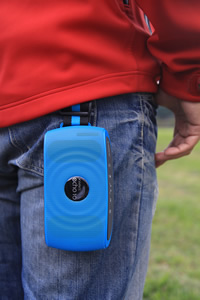|
Volume 20, No. 1 - Winter 2012 |
Subscribe to AT Messenger Download PDF Viewer |
| PDF Version (for printing) Large Print (PDF) Text Version |
That’s AT?
Karen Latimer
Assistive Technology Specialist
DATI, Center for Disabilities Studies, University of Delaware
I often come across gadgets in the store or on the internet that I think would be great additions to our “AT Tool Box”. These items are usually marketed to a target audience or those without disabilities, so why would we consider them Assistive Technologies?
The Assistive Technology Act of 2004 defines an assistive technology device as: “…any item, piece of equipment, or product system, whether acquired commercially, modified, or customized, that is used to increase, maintain, or improve functional capabilities of individuals with disabilities.” (29 U.S.C. Sec 2202(2)). What kinds of things is Congress talking about here? Just about everything! Which is why we can look at all technologies that are brought to the market with “AT Eyes.”
Let’s look at some technologies currently being developed for the mainstream market with our AT EYES. These include tools for home safety/security/automation, fitness and some so-called “smart” technology options. The increase in popularity of these tools is due in part to the increased ability of wireless technology including Bluetooth®. Bluetooth® is merely a trademarked name for a wireless technology that uses shortwave radio waves to interconnect devices such as cell phones, printers, computers, and other devices.
 Cuff Smart Jewelry, coming to market next year, is one such device that combines fashion and technology and, when viewed through AT EYES, offers some interesting applications for individuals with disabilities. https://cuff.io/ The device itself is a small chip that can be put into several types of fashionable jewelry (bracelet, necklace, and cuff) and will interact with an app on your cell phone or tablet. The jewelry can notify you of phone calls, text messages or alarms (by vibration), or send a help signal to a caregiver with a double press of the chip. It will also function as an activity tracker, monitoring the level of activity of the user. Other features are currently being explored. Pre-orders of the Cuff are starting at $49.00, a very reasonable piece of assistive technology!
Cuff Smart Jewelry, coming to market next year, is one such device that combines fashion and technology and, when viewed through AT EYES, offers some interesting applications for individuals with disabilities. https://cuff.io/ The device itself is a small chip that can be put into several types of fashionable jewelry (bracelet, necklace, and cuff) and will interact with an app on your cell phone or tablet. The jewelry can notify you of phone calls, text messages or alarms (by vibration), or send a help signal to a caregiver with a double press of the chip. It will also function as an activity tracker, monitoring the level of activity of the user. Other features are currently being explored. Pre-orders of the Cuff are starting at $49.00, a very reasonable piece of assistive technology!
Recently arrived on the market is the Amazon Echo. A voice-controlled home assistant will access the internet for simple questions like “What is the weather tomorrow?” as well as keep track of grocery lists, play your favorite music, or create an alarm. Connected by Bluetooth to a wireless home network (Internet), this device has the potential to access a great number of home activities for individuals who prefer to use their voice to control their computers. This device has apps for iPhones and Android devices. Retail price is $179.00. http://www.amazon.com/oc/echo/ref_=ods_dp_ae
Also in the area of home automation is a line of controls by Belkin called the WeMo. This family of components allows users to control a wide range of home electronics, water, power, and Wi-Fi from your smartphone, or tablet. There is even a We-Mo enabled Crock-pot! These products retail at major home improvement stores such as Home Depot, making them easy to find, install, and use for the average homeowner! $39.99-$199.99 http://www.belkin.com/us/products/home-automation/c/wemo-home-automation
 The popularity of applications available on telephones, tablets and other smart devices has led to an increase in devices designed to amplify the sound from these smaller devices. This is particularly important for individuals who use apps/tablets/phones for augmentative communication (“AAC”) purposes or for educators who use these devices in the classroom. Portable speakers that can be connected through Bluetooth® are coming down in price and going up in quality. A quick search online will bring up an astonishing number of speakers in all sizes, colors and shapes. Some of the most interesting for use with AAC devices include “wearable” devices such as the XWAVE Echo (picture), which retails at Amazon for $79.99.
The popularity of applications available on telephones, tablets and other smart devices has led to an increase in devices designed to amplify the sound from these smaller devices. This is particularly important for individuals who use apps/tablets/phones for augmentative communication (“AAC”) purposes or for educators who use these devices in the classroom. Portable speakers that can be connected through Bluetooth® are coming down in price and going up in quality. A quick search online will bring up an astonishing number of speakers in all sizes, colors and shapes. Some of the most interesting for use with AAC devices include “wearable” devices such as the XWAVE Echo (picture), which retails at Amazon for $79.99.
Some of these products, specifically the WeMo and a variety of Bluetooth speakers, are available through the DATI Lending Library. We will be evaluating the effectiveness of the other items for possible inclusion as they become available on the market. If you purchase or own any of the products, please write to us and let us know how they are “assistive technology” to you!

